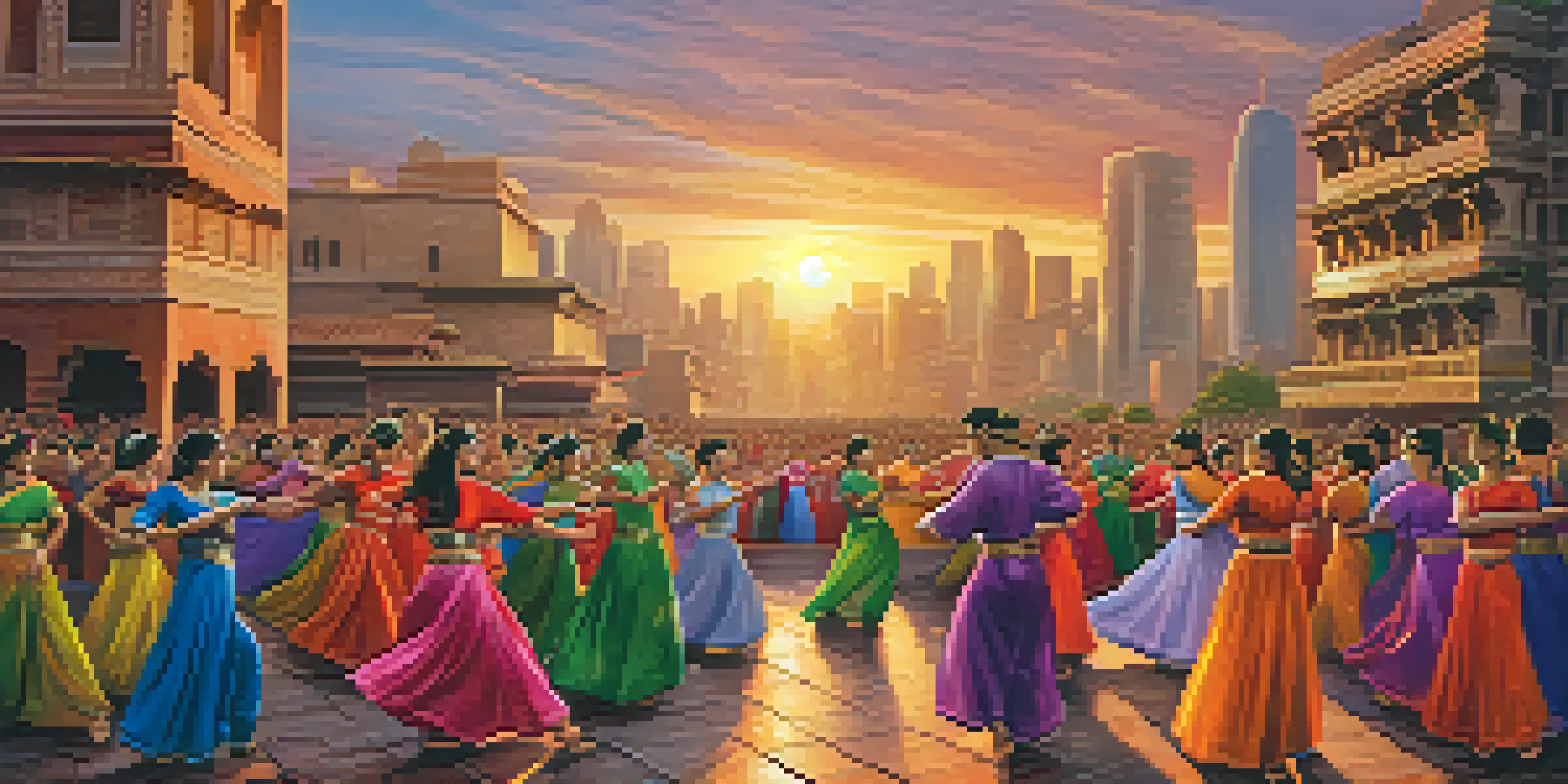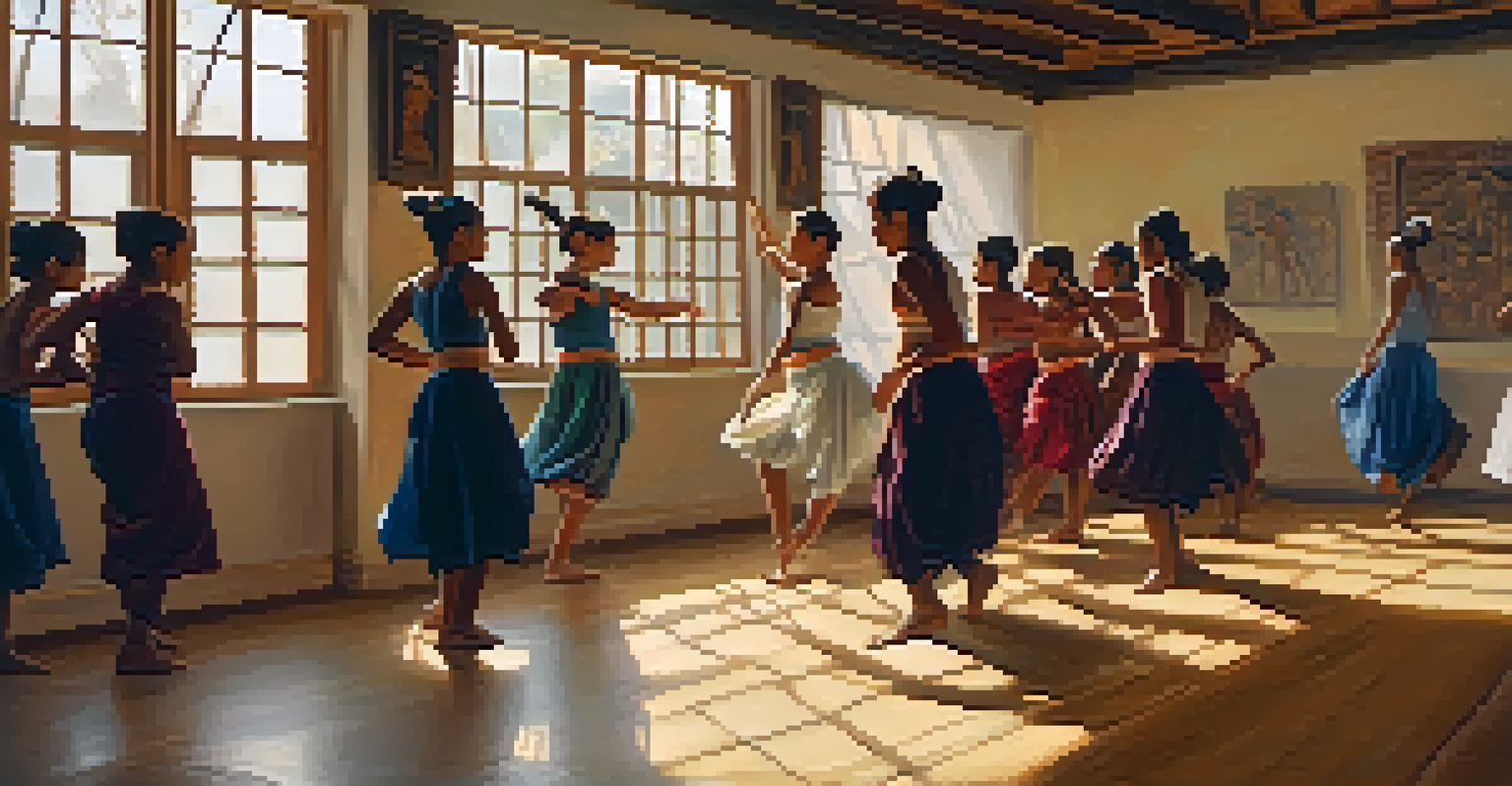The Impact of Globalization on Traditional Dance Forms Worldwide

Understanding Globalization and Its Reach
Globalization refers to the interconnectedness of cultures, economies, and societies across the globe. It's a phenomenon that has accelerated in recent decades due to advancements in technology, communication, and travel. As cultures blend, they can influence each other in both positive and negative ways, particularly in the realm of artistic expression.
Cultural exchange is a two-way street, enriching our understanding of each other and the world we live in.
When we think of globalization, we often picture bustling cities and modern technology. However, it equally affects cultural practices, including traditional dance forms that have been passed down through generations. As these dance forms encounter new audiences and influences, they may evolve or risk fading away into obscurity.
For example, a traditional dance from one culture might be adapted with modern music or choreography, creating a fusion style that resonates with a global audience. This blending can spark interest in traditional forms while also challenging their authenticity and original meaning.
Preservation of Traditional Dance Amid Change
Despite the challenges posed by globalization, many communities actively work to preserve their traditional dance forms. Cultural organizations, schools, and local governments often support initiatives aimed at educating younger generations about their heritage. These efforts ensure that the knowledge and skills associated with traditional dances are passed down.

Workshops, competitions, and festivals serve as platforms for showcasing traditional dances, helping to maintain their relevance in a rapidly changing world. By participating in such events, dancers not only celebrate their cultural identity but also create connections with audiences who may be unfamiliar with their traditions.
Globalization Influences Dance Forms
Globalization fosters a blend of traditional and modern dance styles, creating new expressions while challenging cultural authenticity.
In countries like India, for instance, classical dance forms such as Bharatanatyam or Kathak continue to thrive, thanks in part to educational programs that teach these dance styles. This dedication to preservation highlights the resilience of cultural practices even in the face of globalization.
The Role of Social Media in Dance Evolution
Social media has revolutionized how traditional dance forms are shared and experienced. Platforms like Instagram and TikTok allow dancers to showcase their skills to a global audience, often blending traditional styles with contemporary trends. This exposure can generate interest in traditional dances that might otherwise remain localized.
Tradition is not the worship of ashes, but the preservation of fire.
However, there is a double-edged sword here; while social media can promote traditional dances, it can also lead to oversimplification or misrepresentation. Viral trends may strip away the cultural significance, reducing complex dances to mere entertainment for clicks and likes.
Nonetheless, the ability to reach a wider audience can also lead to greater appreciation and understanding of these art forms. For instance, a traditional dance challenge on social media can inspire participants to learn about its cultural roots, fostering a deeper connection to the dance and its history.
Cultural Exchange: A Two-Way Street
Globalization fosters cultural exchange, allowing traditional dance forms to not only influence but also be influenced by other cultures. Dancers traveling for workshops or performances often share techniques, styles, and narratives, enriching their own traditions. This exchange can lead to exciting new interpretations of traditional dances.
For example, a traditional African dance might incorporate elements from hip-hop, creating a vibrant fusion that engages younger audiences. Such interactions can breathe new life into traditional practices while honoring their roots, exemplifying the dynamic nature of cultural expression.
Social Media's Role in Dance Sharing
Social media platforms allow traditional dances to reach global audiences, promoting cultural appreciation but also risking oversimplification.
This blending of styles can also create opportunities for collaboration among dancers from diverse backgrounds, promoting understanding and appreciation of different cultures. In this way, globalization can act as a catalyst for artistic innovation while preserving the essence of traditional dance.
Commercialization of Dance: Pros and Cons
The commercialization of traditional dance forms is another significant impact of globalization. As these dances gain popularity, they often become part of entertainment industries, leading to increased funding and visibility. This can be a boon for traditional artists, providing them with more opportunities to showcase their work.
However, commercialization can also lead to the commodification of culture, where dances are presented without their original context or meaning. This transformation might strip away the cultural narratives that give these dances their significance, reducing them to mere performances for profit.
Balancing commercialization with cultural authenticity is crucial. While financial support can help sustain traditional dance, it's essential to ensure that the cultural messages and histories behind the dances remain intact and respected.
The Impact of Urbanization on Dance Practices
Urbanization, often driven by globalization, has transformed how traditional dances are practiced and perceived. As people migrate to cities, they bring their cultural practices with them, resulting in a melting pot of styles and influences. This urban environment can lead to the evolution of dance forms as they adapt to new contexts and audiences.
In urban settings, traditional dances may find new expressions, often merging with local styles. For example, traditional folk dances might be performed alongside street dance styles in community events, creating a new cultural dialogue. This blending can attract younger audiences who may not have engaged with traditional forms otherwise.
Preserving Tradition Amid Change
Communities actively work to preserve traditional dance forms through education and cultural events, ensuring their relevance in a rapidly evolving world.
However, the fast-paced life of urban centers can also threaten traditional practices as people become disconnected from their roots. Maintaining a balance between embracing urban influences and honoring traditional dance is key to keeping cultural legacies alive.
Conclusion: Balancing Tradition and Modernity
As globalization continues to shape the world, traditional dance forms are at a crossroads. The interplay between preservation and evolution presents unique challenges and opportunities. Dancers and cultural advocates must navigate this landscape thoughtfully to ensure that the essence of traditional dances is preserved while allowing them to evolve.
Engaging in open dialogues about the significance of these dances can help communities appreciate their cultural heritage while also inviting new interpretations. By celebrating both tradition and innovation, we can create a vibrant cultural tapestry that honors our diverse histories.

Ultimately, the impact of globalization on traditional dance forms is a reflection of our interconnected world. Embracing this complexity can lead to richer, more inclusive cultural experiences that resonate across generations.